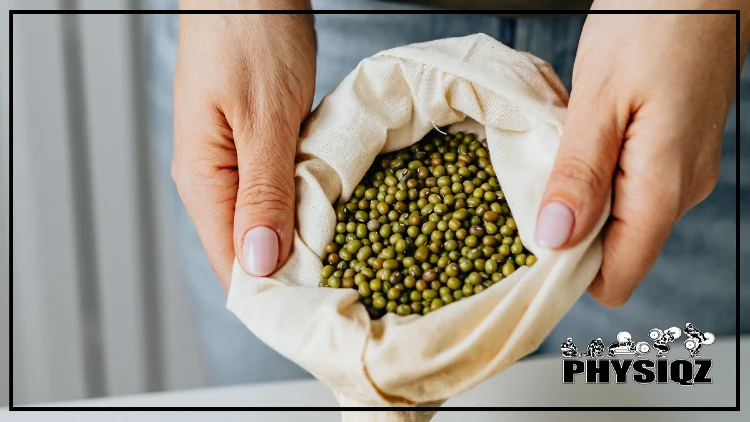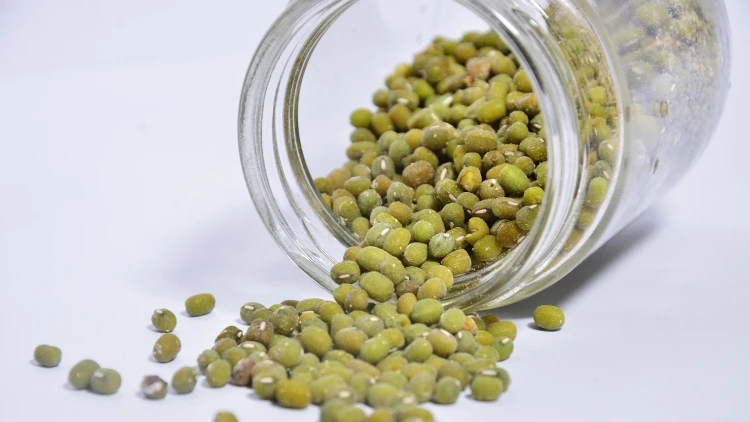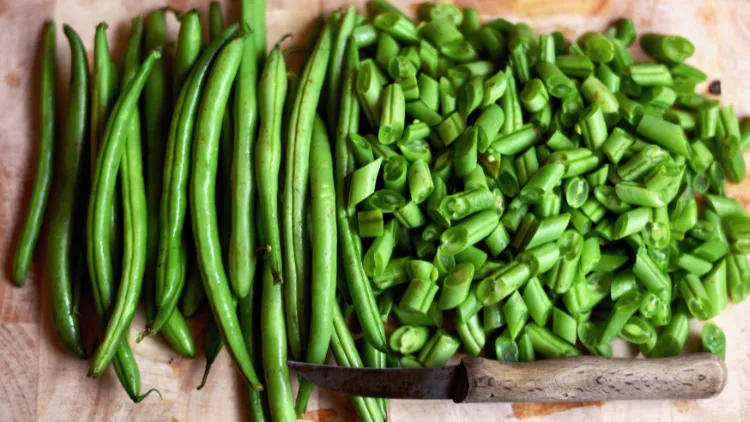
Mung beans themselves are not keto-friendly, but mung bean sprouts are, as they contain only one-sixth the carbs of the actual beans. For those who still want to include mung beans in their diet, we will explore the carb content, compare the nutritional value of mung beans and their sprouts, and suggest low-carb alternatives that are more suitable for a mung bean keto diet.1
How Many Carbs Are in Mung Beans?

Source: Gambar Ratna Fitry via Canva.com2
According to the U.S. Department of Agriculture, mung beans have a significantly high number of carbs at 8 grams of carbohydrates for 1 tablespoon.3 As the serving size increases to 1 cup of boiled mung beans there are a whopping 39 grams of carbohydrates.
Based on that information, it is clear to see whether mung bean on a keto diet is unfortunately a no and they are not considered to be a low carb bean.
Mung Bean Nutritional Information
Even though mung beans are best avoided while on a keto diet, someone may still be curious about the nutrition information of these beans.
While serving sizes will vary, to reap the most health benefits mung beans provide it is recommended to consume 1 cup of mung beans a day. Because of this, below is a macro breakdown for 1 cup of boiled mung beans.
- Calories: 213
- Fat: 0.8 grams
- Sodium: 4 mg
- Total Carbohydrates: 39 grams
- Fiber: 15 grams
- Net Carbohydrates: 24 grams
- Sugar: 4 grams
- Protein: 14 grams
Additionally, there are a variety of different vitamins and minerals found in mung beans. Here is a list of the vitamins and minerals and their daily percentage value, based on a 2,000-calorie diet and a serving size of 1 cup.
- Vitamin: C 3%
- Iron: 15%
- Vitamin B6: 5%
- Magnesium: 24%
- Calcium: 5%
Is Mung Bean Keto-Approved?
Unfortunately, the answer to the question is that mung beans are a no-go for keto. In fact, there are better low carb bean options someone following keto should include in their diet instead of mung beans.
While the ketogenic diet has a number of different varieties, in order for someone to achieve ketosis it is typically recommended to limit carbohydrate intake to no more than 50 grams per day, with some recommendations suggesting limiting carbs to as low as 20 grams per day.4
Getting into the specifics of the keto diet, often it’s recommended to follow a macro breakdown of 70-80% fat, 10-20% protein, and 5-10% carbohydrates.5 If these recommendations aren’t followed, it’s possible to experience the dreaded situation of being in ketosis without losing weight.
Based on that information, and knowing that 1 cup of boiled mung beans contains 39 grams of carbohydrates, it’s clear that there are too many carbs in mung beans to be suitable for keto.
Mung Beans vs Mung Beans Sprouts
While mung beans are not typically considered keto, it’s possible to be curious about mung bean sprouts and whether those would be keto-approved. Mung bean sprouts are sprouts that grow from soaked mung beans.

Source: baseimage via Canva.com6
These can sprout within hours and typically take between 3 and 6 days to grow. Mung beans can be purchased sprouted from most grocery stores or someone could grow them themselves by soaking the mung beans in water overnight then draining and rinsing them and repeating that process until the sprouts reach the desired length.
Compared with mung beans, the sprouts have a significantly smaller number of carbs and would be acceptable while on a keto diet. 1 cup of boiled mung beans has 39 grams of carbs whereas 1 cup of mung bean sprouts has only 6 grams of carbs.
Additionally, they have a lot of health benefits.
It is important to note that consuming raw sprouts should be done with caution because they could potentially have bacteria that can cause foodborne illnesses.7 Furthermore, the FDA recommends that anyone with a weakened immune system, children, the elderly, and pregnant women should not eat raw sprouts.
If bean sprouts are cooked thoroughly they are safe and there is no longer a risk of foodborne illness.
How Many Carbs Are in Mung Bean Sprouts & Nutrition Info of Sprouts
Mung bean sprouts have significantly fewer carbs compared to mung beans with only 6 grams of carbohydrates and 4 grams of net carbs for each cup of sprouts.
Here is the nutritional information for 1 serving size of mung bean sprouts which is equivalent to ¾ cup or 85 grams which also shows how many carbs in mung bean sprouts there are.
- Calories: 30
- Fat: 0 grams
- Sodium: 5 mg
- Total Carbohydrates: 5 grams
- Fiber: 2 grams
- Net Carbohydrates: 3 grams
- Sugar: 4 grams
- Protein: 3 grams
Furthermore, mung bean sprouts do contain vitamins and minerals. There are 10 mg of calcium, 0.7 mg of iron, and 16 mg of vitamin C.
Here are vitamins to help with weight loss.
Are Mung Beans Sprouts Keto?
Despite mung bean not being allowed on a keto diet, mung bean sprouts are definitely something that could be added. In one serving size which is ¾ a cup of sprouts there are only 3 grams of net carbs, making these a great addition to a keto meal plan.
It is worth noting that mung bean sprouts have zero grams of fat for one serving size. A standard keto diet calls for 70% of the daily calories to come from fat.
With mung bean sprouts being a very low-fat food it’s important to be sure to include other foods with high-fat contents.8
Mung Bean Keto Alternatives & Low Carb Beans
After discovering that mung beans are not keto-friendly, keto dieters may be curious to know what are some low carb bean options that would be acceptable on a keto diet. While most beans typically do have a high number of carbs and are best avoided on keto there are some low carb options.

Source: congerdesign for Pixabay9
Here are 3 low carb bean alternatives to mung beans that are keto friendly beans.
- Green Beans: One cup of green cups contains 4 net carbohydrates. Not only do green beans have a low number of carbs for a fairly large serving size, but they are also a good source of folate and potassium, which have been associated with lower blood pressure.10
- Black Soybeans: Black soybeans have a salty flavor and are a very popular ingredient in Chinese cooking. They actually have a different texture and taste compared to a black bean. If you’re wondering whether black-eyed peas and black beans are keto-friendly, both are relatively high in carbohydrates, making them less suitable for a keto diet, though they can be consumed in moderation.
For a serving size of ½ cup black soybeans have 5 grams of net carbohydrates and 11 grams of protein. - Lupini Beans: Lupini beans are a high protein and high fiber bean that can even lower cholesterol.11 These beans are typically enjoyed pickled and Brami has a great option that has 0 net carbohydrates, making them the lowest carb beans.
Health Benefits of Mung Bean Sprouts
While the answer to mung bean on a keto diet is no, mung bean sprouts can be enjoyed on keto and possess a wide range of powerful health benefits. It’s incredible to know that there are a lot of significant changes that mung beans go through during the germination process, including higher levels of nutrients and significantly fewer carbs.
There are 5 incredible health benefits mung bean sprouts have below.
- High Levels of Antioxidants & Vitamin C: Mung bean sprouts are formed through the germination of mung beans. Research has shown that after the germination process, mung bean sprouts have significantly higher levels of vitamin C and 6 times more antioxidant activity.12
- Potential Aid to Weight Loss: These sprouts are could be a great snack to add for someone trying to lose weight and could be a potential weight loss solution. They have a low number of calories at only 30 calories per ¾ cup.
Additionally, they are full of water and have a low-caloric density, foods with these qualities have been shown to help someone feel full for longer.13 - Improve Digestion: Because the sprouts have high levels of insoluble dietary fiber they help aid digestion and can also keep someone regular. Furthermore, research has shown that insoluble fiber may play a particularly important role in weight loss when consuming a diet high in fat like keto.14
- Heart Health: Through research, it’s been discovered that mung bean sprouts have the possibility to lower blood sugar and reduce lipid proteins in the blood.15
- Reduce Disease Risk: Mung bean sprouts have the potential to reduce the risk of diabetes, high blood pressure, and abnormal cell growth.16
Benefits of Low-Carb Beans
Most beans have a very high number of carbs and should be strictly avoided while on a keto diet. In addition, beans have a lot of protein and fiber so they typically are a great option for many meal plans.
For reference here are some common beans and their carb content compared with three different low carb bean carbohydrates.
| Bean Type | Net Carbohydrates (1 cup serving size) |
| Black Beans | 26 grams |
| Pinto Beans | 30 grams |
| Chickpeas | 32.5 grams |
| Green Beans | 4 grams |
| Black Soybeans | 10 grams |
| Lupini beans | 0 grams |
Comparing the low carb bean options to some popular beans is very eye-opening and it is clear to see that most beans should definitely be avoided while following keto.
Green beans, black soybeans, and lupini beans are all fantastic, healthy options that allow someone following a keto diet or another low-carb plan to enjoy beans.
Mung bean sprouts provide a wide range of unique health benefits while also being low-calorie, low-carb, low-fat, and keto-approved. While the question of is mung bean keto is a no, there are actually three low-carb bean alternatives that could be enjoyed on keto.
Frequently Asked Questions
Are Mung Bean Noodles Keto Approved?
Mung bean noodles should be avoided on a keto diet because, for 1 serving size which is 56 grams, there are 50 grams of carbohydrates.
Is Mung Bean Starch Keto?
Mung bean starch does have a lot of fiber but for the one serving size of ¼ cup, there are 33 grams of carbohydrates and 17 grams of net carbs. That being said, mung bean starch has too many carbs to be suitable while on keto.
Are Bean Sprouts Keto-Friendly? Do Bean Sprouts Have Carbs?
Yes, bean sprouts are keto-friendly! For 1 serving size which is ¾ cup there are only 3 net carbs making bean sprouts a great option to add to a keto meal plan.
References
1Karolina Grabowska. “Person Holding Black and Yellow Beads in White Paper Bag.” Canva. Accessed 8 April 2023. <https://www.canva.com/photos/MAENDxTugyI-a-person-holding-a-bag-of-mung-beans/>
2Gambar Ratna Fitry. “mung beans on a bottle.” Canva. Accessed 8 April 2023. <https://www.canva.com/photos/MAFIO459RYA-mung-beans-on-a-bottle/>
3U.S. Department of Agriculture. (2023). Mung beans, mature seeds, raw. FoodData Central. <https://fdc.nal.usda.gov/fdc-app.html#/food-details/174256/nutrients>
4Masood, W., Annamaraju, P., & Uppaluri, K. R. (2022). Ketogenic Diet. StatPearls [Internet]. <https://www.ncbi.nlm.nih.gov/books/NBK499830/>
5Harvard T.H. Chan School of Public Health. (2023). Diet Review: Ketogenic Diet for Weight Loss. The Nutrition Source. <https://www.hsph.harvard.edu/nutritionsource/healthy-weight/diet-reviews/ketogenic-diet/>
6baseimage. “Mung Bean Sprouts.” Canva. Accessed 8 April 2023. <https://www.canva.com/photos/MAExW12u0GU-mung-bean-sprouts/>
7UCONN College of Agriculture, Health, and Natural Resources. (2023). Seed and Bean Sprouts. Food Safety. <https://foodsafety.uconn.edu/seed-and-bean-sprouts/>
8Shilpa, J., & Mohan, V. (2018). Ketogenic diets: Boon or bane? Indian J Med Res, 148(3), 251-253. <https://www.ncbi.nlm.nih.gov/pmc/articles/PMC6251269/>
9congerdesign. Canva. Accessed 8 April 2023. <https://www.canva.com/photos/MAELMAbiZZE/>
10Xun, P., Liu, K., Loria, C. M., Bujnowski, D., Shikany, J. M., Schreiner, P. J., Sidney, S., & He, K. (2012). Folate intake and incidence of hypertension among American young adults: a 20-y follow-up study. Am J Clin Nutr, 95(5), 1023-1030. <https://www.ncbi.nlm.nih.gov/pmc/articles/PMC3325831/>
11Bahr, M., Fechner, A., Kramer, J., Kiehntopf, M., & Jahreis, G. (2013). Lupin protein positively affects plasma LDL cholesterol and LDL:HDL cholesterol ratio in hypercholesterolemic adults after four weeks of supplementation: a randomized, controlled crossover study. Nutr J. <https://www.ncbi.nlm.nih.gov/pmc/articles/PMC3735452/>
12Guo, X., Li, T., Tang, K., & Liu, R. H. (2012). Effect of germination on phytochemical profiles and antioxidant activity of mung bean sprouts (Vigna radiata). J Agric Food Chem, 60(44). <https://pubmed.ncbi.nlm.nih.gov/23088738/>
13Buckland, N. J., Camidge, D., Croden, F., Lavin, J. H., Stubbs, R. J., Hetherington, M. M., Blundell, J. E., & Finlayson, G. (2018). A Low Energy–Dense Diet in the Context of a Weight-Management Program Affects Appetite Control in Overweight and Obese Women. J Nutr, 148(5), 798-806. <https://www.ncbi.nlm.nih.gov/pmc/articles/PMC6054218/>
14Lattimer, J. M., & Haub, M. D. (2012). Effects of Dietary Fiber and Its Components on Metabolic Health. Nutrients, 2(12), 1266-1289. <https://www.ncbi.nlm.nih.gov/pmc/articles/PMC3257631/>
15Hou, D., Yousaf, L., Xue, Y., Hu, J., Wu, J., Hu, X., Feng, N., & Shen, Q. (2019). Mung Bean (Vigna radiata L.): Bioactive Polyphenols, Polysaccharides, Peptides, and Health Benefits. Nutrients, 11(6), 1238. <https://www.ncbi.nlm.nih.gov/pmc/articles/PMC6627095/>
16Tang, D., Dong, Y., Ren, H., Li, L., & He, C. (2014). A review of phytochemistry, metabolite changes, and medicinal uses of the common food mung bean and its sprouts (Vigna radiata). Chem Cent J. <https://www.ncbi.nlm.nih.gov/pmc/articles/PMC3899625/>